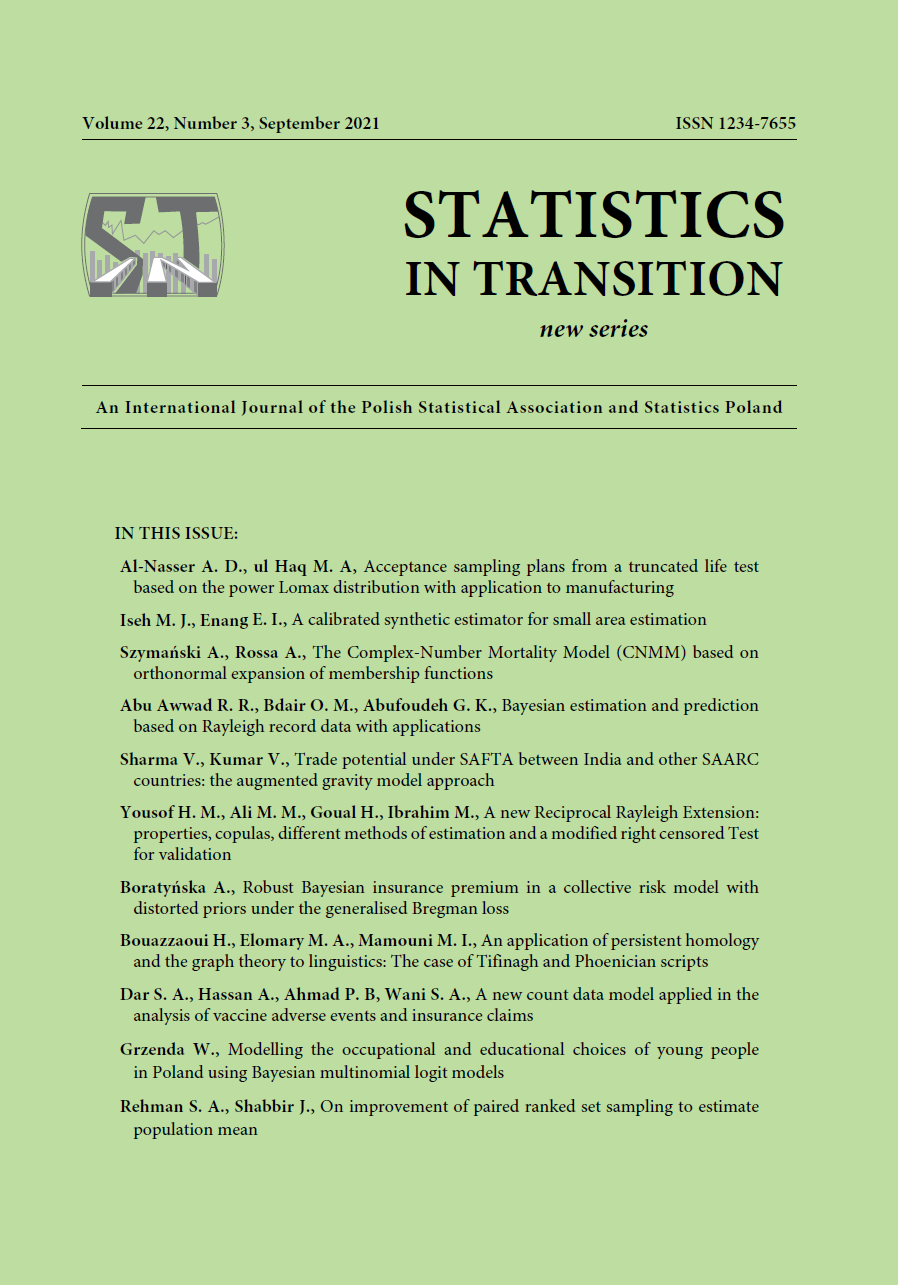ARTICLE
ABSTRACT
In ecological and environmental sampling the quantification of units is either difficult or overly demanding in terms of the time, money, workload, it requires. For this reason efficient and cost-effective sampling methods need to be devised for data collecting. The most commonly used method for this purpose is the Ranked Set Sampling (RSS). In this paper, a sampling scheme called Improved Paired Ranked Set Sampling (IPRSS) is proposed to estimate the population mean. The performance of the proposed IPRSS is evaluated under perfect and imperfect rankings. A simulation study based on selected hypothetical distributions and a real-life data set showed that IPRSS is more precise than RSS, Paired RSS (PRSS) or Extreme RSS (ERSS).
KEYWORDS
order statistics, ranked set sampling, relative efficiency, unbiased estimator, imperfect ranking
REFERENCES
Al-Saleh, M. F. and Al-Hadrami, S. A. (2003). Parametric estimation for the location parameter for symmetric distributions using moving extremes ranked set sampling with application to trees data. Environmetrics: The official journal of the International Environmetrics Society, 14(7):651–664.
Al-Saleh, M. F. and Al-Shrafat, K. (2001). Estimation of average milk yield using ranked set sampling. Environmetrics: The official journal of the International Environmetrics Society, 12(4):395–399.
Arnold, B. C., Balakrishnan, N., and Nagaraja, H. N. (1992). A first course in order statistics, vol. 54. SIAM, Philadelphia.
Biradar, B. and Santosha, C. (2015). Estimation of the population mean based on extremes ranked set sampling. American Journal of Mathematics and Statistics, 5(1):32–36.
Buchanan, R. A., Conquest, L. L., and Courbois, J.-Y. (2005). A cost analysis of ranked set sampling to estimate a population mean. Environmetrics: The official journal of the International Environmetrics Society, 16(3):235–256.
Chen, Z., Bai, Z., and Sinha, B. (2003). Ranked set sampling: theory and applications, volume 176. Springer Science & Business Media.
David, H. A. and Nagaraja, H. N. (2003). Order Statistics. JohnWiley and Sons New York, 3 edition.
Dell, T. and Clutter, J. (1972). Ranked set sampling theory with order statistics background. Biometrics, pages 545–555.
Haq, A., Brown, J., Moltchanova, E., and Al-Omari, A. I. (2013). Partial ranked set sampling design. Environmetrics, 24(3):201–207.
Johnson, G., Patil, G., and Sinha, A. (1993). Ranked set sampling for vegetation research. Abstracta Botanica, pages 87–102.
Lynne Stokes, S. (1977). Ranked set sampling with concomitant variables. Communications in Statistics-Theory and Methods, 6(12):1207–1211.
McIntyre, G. (1952). A method for unbiased selective sampling, using ranked sets. Australian journal of agricultural research, 3(4):385–390.
Mode, N. A., Conquest, L. L., and Marker, D. A. (1999). Ranked set sampling for ecological research: accounting for the total costs of sampling. Environmetrics: The official journal of the International Environmetrics Society, 10(2):179–194.
Muttlak, H. (1998). Median ranked set sampling with concomitant variables and a comparison with ranked set sampling and regression estimators. Environmetrics: The official journal of the International Environmetrics Society, 9(3):255–267.
Muttlak, H. A. (1996). Pair rank set sampling. Biometrical journal, 38(7):879–885.
Muttlak, H. A. (2003). Investigating the use of quartile ranked set samples for estimating the population mean. Applied Mathematics and Computation, 146(2-3):437–443.
Patil, G. (1995). ranked set sampling. Environmental and Ecological Statistics, 2(4):271– 285.
Samawi, H. M., Ahmed, M. S., and Abu-Dayyeh, W. (1996). Estimating the population mean using extreme ranked set sampling. Biometrical Journal, 38(5):577–586.
Singh, R. and Mangat, N. S. (2013). Elements of survey sampling, volume 15. Springer Science & Business Media.
Takahasi, K. and Wakimoto, K. (1968). On unbiased estimates of the population mean based on the sample stratified by means of ordering. Annals of the institute of statistical mathematics, 20(1):1–31.
Yu, P. L. and Tam, C. Y. (2002). Ranked set sampling in the presence of censored data. Environmetrics: The official journal of the International Environmetrics Society, 13(4):379– 396.
